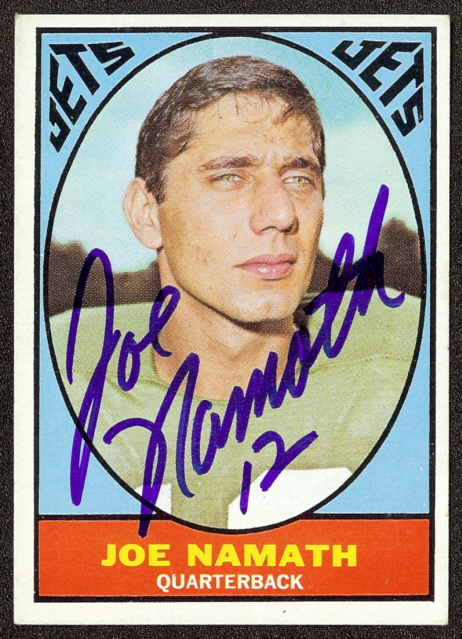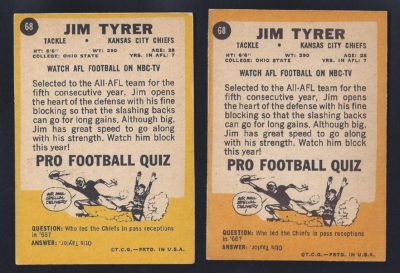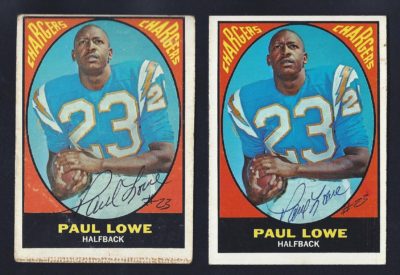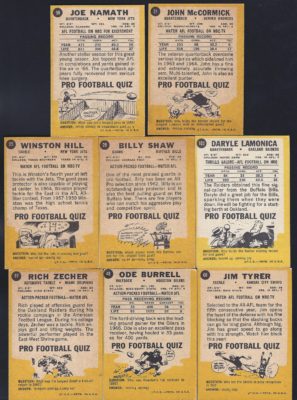I thought I knew AFL-era trading cards pretty well. I’ve been collecting them, both with and without signatures, for a couple of decades. I’ve bought them, sold them, traded them, read about them, talked about them and written about them. I’ve sorted cards, made lists of cards, got cards graded, admired collections… I know a bit about cards. So you can imagine my shock when I purchased an autographed 1967 Milton Bradley Paul Lowe card on eBay last week, and after a bit of research came to the conclusion that I had filled one of my sets with incorrect cards.
Although I had never pursued the set, I had known that in 1967, Topps made a set of trading cards for the board game company, Milton Bradley, to be used in one of their games. I knew that they looked almost identical to the standard 1967 Topps football cards, but I assumed that there was some sort of marking that differentiated the Topps cards from Milton Bradley. Apparently, I was wrong.
There are two ways to tell between the card types, and both can be a bit vague. First, and the one that should always work, is by checking the color of the printing on the card backs. The difference can be slight at times, but the Milton Bradley cards have a bright yellow back, while their Topps counterparts have a darker gold color.
The other thing to look for is more obvious, but unfortunately only appears on some of the Milton Bradley cards. In addition to 1967 Topps football cards, the board game for which these cards were made also used a version of the 1968 Topps baseball and 1968 Topps Hot Rod cards. As these were all special issue cards, they were printed together on a single sheet. On the sheet, the rows of football cards were placed in-between rows of the 1968 baseball cards. As a result, if the centering was off a bit when the cards were being cut from sheets, a thin sliver of the burlap pattern from the baseball cards will be left on either the top or bottom edge of the football cards.

Bottom edge of the 1967 Milton Bradley Paul Lowe card, with residual burlap design from 1968 Milton Bradley baseball card.
After exchanging information with a very advanced collector of the Milton Bradley cards, I learned that he believes there to to be a roughly 30-to-1 ratio of Topps to Milton Bradley football cards. He believes baseball cards are more along the lines of 100-to-1. So the Milton Bradley card are more rare than the Topps, but honestly, few dealers and collectors know enough to make the distinction. This is where I enter into the picture. Because after looking through my fully-autographed 1967 “Topps” set, I realized that eight of the 132 cards were actually Milton Bradley issues. My Billy Shaw, John McCormick, Ode Burrell, Jim Tyrer, Rich Zecher, Winston Hill, Joe Namath (gulp!) and Daryle Lamonica cards all had bright yellow backs.
I’m not sure whether to be pleased or frustrated. The disappointing part is that a set that I’ve thought for the past two years was already complete, now needs eight additional cards, and I have to replace my Joe Namath! A bit more uplifting, however, is that fact that I’ve already got some of the more difficult cards from the rare Milton Bradley set. In the end, I guess that I will put on my rose colored glasses, take a sip from my half-full cup, and be happy that I have a new set to collect.





I have collected oddball cards for a few decades now and did not know this, I will have to get my 67’s out and take a look. But, even if I did find a few of them to be ‘Milton Bradley’ cards I wouldn’t replace them, and I don’t think you should either. Nowhere on the cards does it say ‘Milton Bradley’, they are 1967 Topps football cards, made by the Topps card company. The reason for the different shade of yellow on the back ?, they were probably printed before or after the regular run of 67 Topps football cards, and the dye was not matched exactly. This situation is similar to the 1974 Topps ‘Parker Bros. Pro Draft’ cards, also issued inside a board game. The cards from the 1974 Parker Bros. game are easier to distinguish, as most had (2)* asterisks rather than one next to the copyright, some had different player poses than the regular 74 Topps cards, and some even had 1972 player statistics rather than the 1973 stats. The 67 Topps football cards that were placed in Milton Bradley games are far less distinguishable, and, the collector you were in contact with says that the ratio is approximately 30-1, yet no valuation difference is made in the Beckett card price guide. I can see not wanting the ugly burlap mark on any of my cards, but if it was simply the shade difference on the back, i’d let it slide. Especially if you had to go to the trouble of getting it autographed again…
[…] posted recently after learning a bit about the 1967 Milton Bradley football cards. Since then I’ve picked up more information about another AFL trading card, one which I […]
I have been collecting these variations for 3 years now. These are very difficult to find in high grade. Autographed cards are even more difficult. Think about it. Someone had to have the game, that is very rare. Save the cards or add them to there collection. If your mom did not throw the game and cards out. Then have that rare variation signed. Come on. As far as value. The market and auctions will tell you that higher grade Milton Bradley cards are off the charts. Sometimes 20x more. The board game is so rare that most of the online board game sites don’t even list it or know what it is. Short print run. The 132 card sheet was printed with 1968 topps baseball, 1967 topps football and 1968 topps hot rod cards. Go to google and type in “tales of the yellow back” … great article about the game and set of cards. 1968 topps yellow name variations are from this set also. The value on those cards are 10x more the the white letter version. I love hunting down variations. I really like the autograph cards you have. Contact the guy who wrote the article listed above. He may be able to help you with your autograph Milton Bradley variation autograph set.
… [Trackback]
[…] Find More Information here to that Topic: talesfromtheamericanfootballleague.com/1967-milton-bradley-afl-cards-a-discovery-for-me/ […]
… [Trackback]
[…] Find More to that Topic: talesfromtheamericanfootballleague.com/1967-milton-bradley-afl-cards-a-discovery-for-me/ […]
… [Trackback]
[…] Info on that Topic: talesfromtheamericanfootballleague.com/1967-milton-bradley-afl-cards-a-discovery-for-me/ […]
… [Trackback]
[…] Here you can find 35438 more Information on that Topic: talesfromtheamericanfootballleague.com/1967-milton-bradley-afl-cards-a-discovery-for-me/ […]
… [Trackback]
[…] There you can find 53272 additional Information on that Topic: talesfromtheamericanfootballleague.com/1967-milton-bradley-afl-cards-a-discovery-for-me/ […]
… [Trackback]
[…] Find More here on that Topic: talesfromtheamericanfootballleague.com/1967-milton-bradley-afl-cards-a-discovery-for-me/ […]
… [Trackback]
[…] There you will find 79897 additional Info to that Topic: talesfromtheamericanfootballleague.com/1967-milton-bradley-afl-cards-a-discovery-for-me/ […]
… [Trackback]
[…] Find More on on that Topic: talesfromtheamericanfootballleague.com/1967-milton-bradley-afl-cards-a-discovery-for-me/ […]
… [Trackback]
[…] Info on that Topic: talesfromtheamericanfootballleague.com/1967-milton-bradley-afl-cards-a-discovery-for-me/ […]
… [Trackback]
[…] Information on that Topic: talesfromtheamericanfootballleague.com/1967-milton-bradley-afl-cards-a-discovery-for-me/ […]
… [Trackback]
[…] There you can find 4191 additional Information to that Topic: talesfromtheamericanfootballleague.com/1967-milton-bradley-afl-cards-a-discovery-for-me/ […]
… [Trackback]
[…] Find More Information here on that Topic: talesfromtheamericanfootballleague.com/1967-milton-bradley-afl-cards-a-discovery-for-me/ […]
… [Trackback]
[…] Info on that Topic: talesfromtheamericanfootballleague.com/1967-milton-bradley-afl-cards-a-discovery-for-me/ […]
… [Trackback]
[…] Info on that Topic: talesfromtheamericanfootballleague.com/1967-milton-bradley-afl-cards-a-discovery-for-me/ […]
… [Trackback]
[…] Find More on that Topic: talesfromtheamericanfootballleague.com/1967-milton-bradley-afl-cards-a-discovery-for-me/ […]
… [Trackback]
[…] Find More Information here to that Topic: talesfromtheamericanfootballleague.com/1967-milton-bradley-afl-cards-a-discovery-for-me/ […]
… [Trackback]
[…] Here you can find 6199 additional Info to that Topic: talesfromtheamericanfootballleague.com/1967-milton-bradley-afl-cards-a-discovery-for-me/ […]
… [Trackback]
[…] Here you will find 50858 more Info to that Topic: talesfromtheamericanfootballleague.com/1967-milton-bradley-afl-cards-a-discovery-for-me/ […]
… [Trackback]
[…] Info to that Topic: talesfromtheamericanfootballleague.com/1967-milton-bradley-afl-cards-a-discovery-for-me/ […]
… [Trackback]
[…] Read More on to that Topic: talesfromtheamericanfootballleague.com/1967-milton-bradley-afl-cards-a-discovery-for-me/ […]
… [Trackback]
[…] Information to that Topic: talesfromtheamericanfootballleague.com/1967-milton-bradley-afl-cards-a-discovery-for-me/ […]
… [Trackback]
[…] Here you will find 81001 additional Info on that Topic: talesfromtheamericanfootballleague.com/1967-milton-bradley-afl-cards-a-discovery-for-me/ […]
… [Trackback]
[…] Here you will find 20775 more Info to that Topic: talesfromtheamericanfootballleague.com/1967-milton-bradley-afl-cards-a-discovery-for-me/ […]
… [Trackback]
[…] Read More here on that Topic: talesfromtheamericanfootballleague.com/1967-milton-bradley-afl-cards-a-discovery-for-me/ […]
… [Trackback]
[…] Find More on to that Topic: talesfromtheamericanfootballleague.com/1967-milton-bradley-afl-cards-a-discovery-for-me/ […]
… [Trackback]
[…] Find More on that Topic: talesfromtheamericanfootballleague.com/1967-milton-bradley-afl-cards-a-discovery-for-me/ […]
… [Trackback]
[…] Find More Info here to that Topic: talesfromtheamericanfootballleague.com/1967-milton-bradley-afl-cards-a-discovery-for-me/ […]